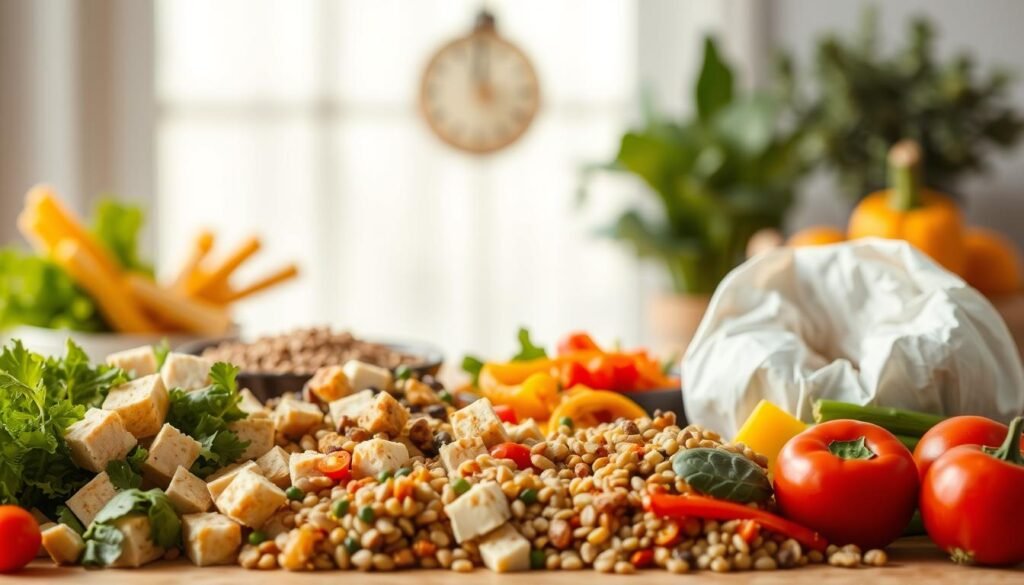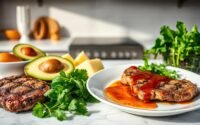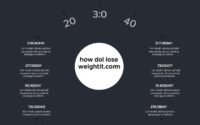Vegetarian High-Protein Diet for Effective Weight Loss
“Let food be thy medicine and medicine be thy food.” – Hippocrates. This timeless quote reminds us of the power of nutrition in shaping our health. Today, more people in the United States are embracing plant-based eating, not just for its ethical benefits but also for its potential to improve well-being.
Studies show that diets rich in plant-based foods can reduce the risk of chronic diseases like heart disease and diabetes. By focusing on nutrient-dense options, you can create a sustainable approach to health that feels good and works long-term.
This guide is designed to help you navigate the world of plant-based eating with ease. From meal plans to practical tips, you’ll find everything you need to get started. Whether you’re new to this lifestyle or looking to refine your habits, this resource is here to support your journey.
Key Takeaways
- Plant-based eating is gaining popularity in the U.S. for its health benefits.
- Studies link vegetarian diets to lower risks of chronic diseases.
- Focus on nutrient-dense foods for sustainable results.
- This guide provides actionable steps for success.
- Includes meal plans, food lists, and practical tips.
Introduction to a High-Protein Vegetarian Diet
Adopting a vegetarian diet doesn’t mean sacrificing essential nutrients like protein. Whether you’re following a vegetarian diet for health, ethical, or environmental reasons, it’s important to understand the different types and how to meet your nutritional needs.
There are several variations of vegetarian eating. A lacto-ovo-vegetarian diet includes dairy and eggs but excludes meat, fish, and poultry. A vegan diet avoids all animal products, while a flexitarian approach incorporates occasional meat or fish. Each type has its benefits, and choosing the right one depends on your preferences and goals.
Protein plays a crucial role in your body. It helps preserve muscle mass, supports metabolism, and keeps you feeling full. Many people worry about meeting their protein intake without meat, but there are plenty of plant-based options available.
Here are some excellent protein sources for a vegetarian diet:
- Lentils: Packed with protein and fiber, lentils are versatile and easy to add to meals.
- Greek Yogurt: A great source of protein and probiotics, ideal for breakfast or snacks.
- Tofu: Made from soybeans, tofu is a complete protein and can be used in various dishes.
- Quinoa: A grain that’s also a complete protein, perfect for salads or side dishes.
Not all vegetarian foods are created equal. While whole, plant-based foods are nutrient-dense, processed vegetarian options can be high in calories and low in nutrients. Focus on incorporating whole foods like vegetables, legumes, and whole grains for optimal health.
| Food | Protein Content (per 100g) |
|---|---|
| Lentils | 9g |
| Greek Yogurt | 10g |
| Tofu | 8g |
| Quinoa | 4g |
By understanding the basics of a vegetarian diet and focusing on nutrient-rich foods, you can easily meet your protein needs and enjoy a balanced, healthy lifestyle.
Benefits of a High-Protein Vegetarian Diet for Weight Loss
A diet rich in plant proteins offers unique advantages for maintaining a healthy lifestyle. Studies show that plant-based eating can help manage your goals effectively. One key benefit is its ability to stabilize blood sugar levels, which reduces cravings and keeps you feeling satisfied longer.
Fiber plays a significant role in this process. Foods like lentils, beans, and whole grains are packed with fiber, which supports digestive health and promotes prolonged fullness. This makes it easier to stick to your plan without feeling deprived.
Research also links plant-based diets to lower obesity rates. A study published in the Journal of Nutrition found that individuals following a vegetarian diet had lower BMIs compared to those consuming meat regularly. This is partly due to the nutrient density of plant foods, which provide essential vitamins and minerals without excess calories.
Another advantage is the reduction of inflammation. Antioxidant-rich vegetables like spinach, kale, and bell peppers help combat inflammation, which is often linked to chronic conditions. Including these foods in your meals can improve overall health and support your journey.
Finally, plant-based eating is often more cost-effective than meat-centric diets. Staples like beans, rice, and seasonal vegetables are affordable and versatile, making it easier to stick to your budget while enjoying nutritious meals.
By focusing on whole, plant-based foods, you can achieve your goals while enjoying a variety of delicious and satisfying meals. This approach not only supports your health but also aligns with a sustainable lifestyle.
Understanding the High-Protein Vegetarian Weight Loss Plan
Balancing your meals with the right nutrients is key to achieving your health goals. A well-structured meal plan ensures you get the energy and nourishment your body needs. For optimal results, aim for a macronutrient split of 25% protein, 30% fat, and 40% carbs. This balance supports muscle maintenance, energy levels, and overall well-being.
Portion control is another essential strategy. Use your fist as a guide for serving sizes. For example, a fist-sized portion of cooked quinoa or roasted veggies is a simple way to manage portions without counting calories. This approach keeps meals satisfying and prevents overeating.
Weekly meal prep can save time and keep you on track. Batch-cook staples like quinoa and roast a variety of vegetables. Store them in containers for easy access throughout the week. Add a splash of almond milk to smoothies or oatmeal for a creamy, protein-rich boost.
Hydration plays a vital role in metabolism. Aim for at least 8 glasses of water daily. Staying hydrated helps your body process nutrients efficiently and keeps energy levels steady.
When grocery shopping, focus on nutrient-dense options. Buy whole grains, chia seeds, and frozen edamame in bulk. These items are versatile, affordable, and packed with essential nutrients. With these tips, you can create a sustainable and effective approach to your health journey.
Barriers to Losing Weight on a Vegetarian Diet
While a plant-based lifestyle offers numerous health benefits, it’s not without its challenges when it comes to achieving specific goals. Understanding these barriers can help you navigate them effectively and stay on track.
Not Eating Enough Protein
One common issue is not consuming enough protein. Protein is essential for maintaining muscle mass and keeping you full. Aim for at least 45 grams daily to avoid deficiencies. Foods like lentils, tofu, and Greek yogurt are excellent sources.
Pre-portioned snacks like almonds can help you meet your daily needs without overeating. Skipping protein-rich meals can lead to muscle loss and increased hunger, making it harder to stick to your plan.
Overeating Refined Carbs
Another challenge is overeating refined carbohydrates. Foods like white pasta and bread can spike blood sugar levels, leading to energy crashes and cravings. Opt for whole grains like quinoa or brown rice instead.
Substituting cauliflower rice for traditional rice is a simple way to reduce carb intake while still enjoying your favorite dishes. This swap keeps meals satisfying without the added calories.

Consuming Too Many Calorie-Rich Foods
Even healthy vegetarian foods can be calorie-dense. For example, just two tablespoons of peanut butter contain 191 calories. While nutritious, these foods should be eaten in moderation to avoid excess calorie intake.
When dining out, be mindful of carb-heavy menus. Many vegetarian options at restaurants are loaded with processed foods and hidden calories. Choose dishes with whole, unprocessed ingredients whenever possible.
By being aware of these barriers and making small adjustments, you can overcome challenges and stay committed to your goals. Focus on balanced meals and mindful eating for long-term success.
Tips for Effective Weight Loss on a Vegetarian Diet
Focusing on nutrient-rich foods can help you feel energized and satisfied throughout the day. By making smart choices, you can support your health goals while enjoying delicious meals. Here are some practical tips to guide you.
Incorporate Protein at Every Meal
Protein is essential for maintaining energy and keeping you full. Start your day with a spinach omelet, which provides about 18g of protein. For lunch, add hemp seeds to your salad for an extra 10g per serving. Snacks like pre-cut bell peppers with hummus are both tasty and protein-packed.
Dinner is another opportunity to include protein. Aim for a protein-rich meal about three hours before bedtime. This helps your body recover overnight and keeps you satisfied until morning.
Choose Whole Foods Over Processed Options
Whole foods like beans, lentils, and whole grains are nutrient-dense and support your goals. Avoid processed options that are often high in empty calories. Instead, fill half your plate with non-starchy vegetables like broccoli, zucchini, or spinach.
These foods are not only low in calories but also rich in fiber, which helps you feel full longer. Pair them with a palm-sized portion of tofu or a cup of cooked quinoa for a balanced meal.
Monitor Portion Sizes
Portion control is key to staying on track. Use simple guides like a fist-sized serving of cooked grains or a palm-sized portion of tofu. This makes it easy to manage your intake without counting calories.
Pre-portion snacks like nuts or seeds to avoid overeating. These small adjustments can make a big difference in your daily routine.
By focusing on these strategies, you can create a sustainable and enjoyable approach to your health journey. Small changes add up over time, leading to lasting results.
Best Vegetarian Foods for Weight Loss
Choosing the right foods can make all the difference in your health journey. Whether you’re looking to stay full longer or boost your energy, these options are packed with nutrients to support your goals. From vibrant vegetables to hearty legumes, here’s a guide to the best plant-based foods to include in your meals.
Non-Starchy Vegetables
Non-starchy vegetables are low in calories but high in fiber and essential vitamins. They’re perfect for adding volume to your meals without extra calories. Broccoli is a standout choice, offering 2.5g of protein per cup. Other great options include spinach, zucchini, and bell peppers.
Roasting these veggies with a drizzle of olive oil enhances their flavor and makes them a delicious side dish. You can also blend them into smoothies or soups for an easy nutrient boost.
Legumes and Beans
Legumes and beans are protein powerhouses that keep you feeling full and satisfied. Black beans provide 15g of protein per cup, making them a versatile addition to salads, soups, or tacos. Lentils are another excellent choice, with 9g of protein per 100g.
For a quick snack, try roasted chickpeas. They’re crunchy, flavorful, and packed with protein. You can also use lentils as a base for taco meat or mix them into stews for extra texture.
Whole Grains and Seeds
Whole grains and seeds are nutrient-dense and provide sustained energy. Quinoa is a complete protein, offering 8g per cup. Amaranth is another grain rich in protein and fiber, perfect for porridge or salads.
Seeds like chia and hemp are great for sprinkling on yogurt or blending into smoothies. Combining brown rice with peas creates a complete protein, making it a budget-friendly and nutritious meal option.

| Food | Protein Content (per 100g) |
|---|---|
| Broccoli | 2.5g |
| Black Beans | 15g |
| Quinoa | 8g |
| Lentils | 9g |
By incorporating these foods into your meals, you can enjoy a variety of flavors while staying on track with your goals. Remember, small changes can lead to big results over time.
Foods to Avoid on a Vegetarian Weight Loss Plan
Not all plant-based foods are created equal—some can hinder your progress if you’re not careful. While many vegetarian meals are nutritious, others may contain hidden processed foods, excess sugar, or unhealthy fats. Knowing what to avoid can help you make smarter choices and stay on track.
Highly Processed Vegetarian Foods
Many convenience foods marketed as vegetarian are highly processed. For example, veggie burgers often contain over 400mg of sodium per serving. Vegan cheeses made with palm oil can also be high in saturated fats. Always check labels for ingredients like “natural flavors” or artificial additives.
Instead of relying on pre-packaged options, try making your own alternatives. A simple cashew cheese sauce can replace store-bought versions, offering a healthier and more natural option.
Refined Carbohydrates
Refined carbs like white bread and pasta can spike blood sugar levels, leading to energy crashes and cravings. These foods lack the fiber and nutrients found in whole grains. Swap them for zucchini noodles (zoodles) or cauliflower rice to reduce carb intake while keeping meals satisfying.
Whole grains like quinoa and brown rice are better choices. They provide sustained energy and help you feel full longer.
Sugary Snacks and Beverages
Sugary snacks and drinks can sabotage your efforts. Flavored almond milk, for instance, often contains 12g of sugar per cup. Similarly, many granola bars and desserts marketed as vegetarian are loaded with added sugars.
Opt for whole fruits or unsweetened beverages instead. These options provide natural sweetness without the extra calories.
| Food to Avoid | Healthier Alternative |
|---|---|
| Veggie Burgers | Homemade Lentil Patties |
| Flavored Almond Milk | Unsweetened Almond Milk |
| White Pasta | Zucchini Noodles |
| Vegan Cheese | DIY Cashew Cheese Sauce |
By avoiding these common pitfalls, you can make your plant-based journey more effective and enjoyable. Focus on whole, unprocessed foods to support your goals and maintain a balanced lifestyle.
Sample 5-Day High-Protein Vegetarian Meal Plan
Creating a structured meal plan can simplify your journey toward better health. By planning ahead, you ensure balanced nutrition while saving time and effort. Here’s a 5-day guide to help you stay on track with delicious and satisfying meals.
Day 1: Balanced Breakfast, Lunch, and Dinner
Start your day with a bowl of Greek yogurt topped with fresh berries and a sprinkle of chia seeds. This breakfast offers 20g of protein and keeps you full until lunch. For your midday meal, try a teriyaki tofu stir-fry with broccoli and brown rice. It’s packed with 30g of protein and essential nutrients.
End the day with a hearty lentil soup paired with a side of roasted vegetables. This combination provides fiber and protein, making it a perfect dinner option.
Day 2: Protein-Packed Meals
Kick off the day with a spinach and feta omelet, offering 18g of protein. For lunch, enjoy a bowl of lentil chili with cauliflower rice. This dish is rich in plant-based protein and fiber, keeping you satisfied all afternoon.
Dinner can be a roasted veggie bowl with halloumi cheese. The combination of colorful vegetables and protein-rich cheese makes it a flavorful and nutritious choice.
Day 3: Nutrient-Rich Options
Begin with a smoothie made with almond milk, banana, and a scoop of plant-based protein powder. For lunch, try a quinoa salad with chickpeas, cucumbers, and a lemon-tahini dressing. This meal is light yet nutrient-dense.
For dinner, prepare a stir-fry with tofu, bell peppers, and snap peas. Serve it over a bed of brown rice for a complete and satisfying meal.
Snack Options and Prep Shortcuts
Keep snacks simple and protein-rich. Hard-boiled eggs and roasted edamame are excellent choices. For meal prep, batch-cook quinoa for three days and roast a variety of vegetables in advance. These shortcuts save time and ensure you always have healthy options on hand.
By following this 5-day meal plan, you can enjoy a variety of flavors while meeting your nutritional needs. Planning ahead makes healthy eating effortless and enjoyable.
How to Stay Consistent with Your High-Protein Vegetarian Diet
Staying consistent with your diet doesn’t have to feel like a chore—it’s all about smart strategies. By focusing on preparation, motivation, and tracking, you can make healthy eating a seamless part of your routine. Here’s how to stay on track and enjoy the process.
Meal Prepping Tips
Preparation is the foundation of consistency. Start by dedicating a few hours on Sunday to prep your meals for the week. Portion chia pudding jars for breakfast or freeze pre-made veggie burger patties for quick dinners. These small steps save time and ensure you always have healthy options ready.
Batch-cooking staples like quinoa or roasted vegetables can also simplify your week. Store them in airtight containers for easy access. Use versatile ingredients like lentils or tofu to create multiple dishes. For example, a simple tahini sauce can transform roasted veggies into a flavorful meal.
Staying Motivated
Motivation can wane over time, but small boosts can keep you inspired. Take monthly progress photos to visually track your journey. Celebrate milestones, like trying a new recipe or sticking to your plan for a month. These moments remind you of how far you’ve come.
Community support is another powerful motivator. Join vegetarian Facebook groups or local meetups to connect with like-minded individuals. Sharing tips and experiences can make the journey feel less lonely and more rewarding.
Tracking Your Progress
Tracking helps you stay accountable and see tangible results. Use apps like MyFitnessPal to monitor your macros and ensure you’re meeting your protein goals. Keep a journal to note how certain foods make you feel or which meals you enjoy most.
Set realistic goals and adjust them as needed. For example, if you’re struggling with portion control, focus on smaller, more frequent meals. Tracking isn’t just about numbers—it’s about understanding your habits and making informed choices.
By incorporating these strategies, you can build a sustainable routine that supports your goals. Remember, consistency is about progress, not perfection. Small steps lead to big results over time.
Conclusion
Focusing on whole foods can transform your approach to healthy eating. By prioritizing protein timing, choosing nutrient-dense options, and practicing portion control, you can create a sustainable routine. Start small—try Meatless Mondays or swap refined carbs for whole grains. These gradual changes make it easier to stick to your goals.
Many people find success with an average of 1-2 pounds lost weekly. Their stories show that consistency is key. To help you get started, download our free meal plan PDF. It’s packed with delicious, balanced recipes to keep you on track.
Remember, progress matters more than perfection. Small steps lead to big results over time. Stay consistent, and you’ll see the benefits of a whole-foods-focused diet.
FAQ
What are the best protein sources for a vegetarian diet?
You can get plenty of protein from foods like tofu, lentils, beans, chia seeds, Greek yogurt, and almond milk. These options are both nutritious and versatile for your meals.
Can I lose weight without eating meat?
Absolutely! By focusing on whole foods like legumes, non-starchy veggies, and whole grains, you can create a calorie deficit while still meeting your protein needs.
How can I avoid overeating carbs on a vegetarian diet?
Choose complex carbs like brown rice and quinoa over refined options. Pair them with protein-rich foods like black beans or sunflower seeds to keep your blood sugar stable.
What are some easy high-protein vegetarian meals?
Try a lentil and veggie bowl, a tofu stir-fry with broccoli, or a Greek yogurt parfait with chia seeds. These meals are quick to prepare and packed with nutrients.
Are there any foods I should avoid on a vegetarian weight loss plan?
Stay away from highly processed vegetarian foods, sugary snacks, and refined carbs. Instead, focus on whole, nutrient-dense options like tomatoes, olive oil, and peanut butter.
How can I stay consistent with my diet?
Meal prepping is key! Plan your meals ahead of time, track your progress, and stay motivated by setting small, achievable goals.
Can I still enjoy dairy products on this plan?
Yes! Dairy products like Greek yogurt and cheese can be great sources of protein. Just be mindful of portion sizes to keep your calorie intake in check.

